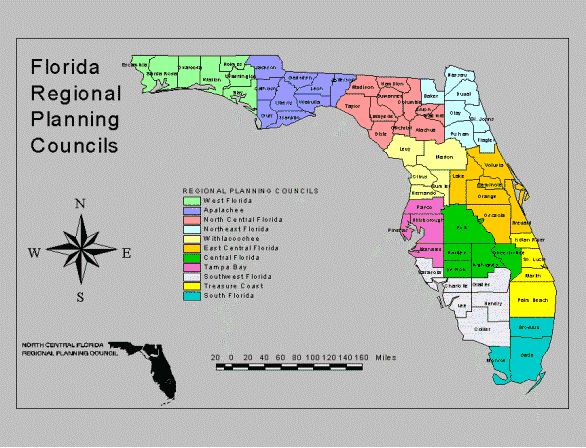|
regional planning in Florida |
|
Florida has a wide variety of regional entities. Each system has different divisions and districts, and each is unique. Together, they seem to criss-cross and overlap in a confusing tangle of bureaucracy. As an example, the state is divided into: ¡¤ 11 regional
planning councils, which are basically think tanks with locally
elected governing boards. They focus on education, transportation,
and some social services (affordable housing) The current debate is on what the best direction should be, whether it should be a top-down approach (mandated by the state), or bottom-up one (trusting the local municipality to act accordingly). Rarely is there agreement. The result is a state whose internal regional boundaries overlap each area in different and confusing patterns. Each regional planning council has a different focus (i.e. the panhandle's focus is on weekend tourism from Alabama and Georgia as well as agriculture, Southeast Florida's is on serving as the gateway to the Caribbean, etc¡¦) The only commonality among the regional planning councils is that all of them coordinate reviews, all of them review the local comprehensive plans, and they all review federally funded projects. Florida has two main
review processes: Outside of these two processes, the municipalities can still sue each other (usually on private sector), which keeps the process a little honest. So, what works in general? The carrot and stick proverb works here. Transportation planning works well because the funding is tied into a regional component -- often in regional planning, the funding has to come from the local government, which does not have the large funds necessary. The planning for utilities also works well for the same reason. The municipalities often need the same utility companies, and it is easier for them to work together because their goals are shared. Thus, they acquire the funding because they demonstrate inter-local government agreements and cooperation. However, there are not that many carrots. What does not work in general? It is very difficult to get local governments to buy into regional planning because of the fear of losing home rule. Here the frontier attitude really sets in. An example of this is the conflict between natural resource management and land-use development, even if there is not an abundance of protected areas. It is the old local vs. state/federal battle. According to Bruce Franklin , a private sector planner in Sarasota, Florida who works with the Southwest Regional Planning Council, regional planning works best with a few localities working together on a common issue like resources (wildlife, water, estuaries, etc¡¦). As a private planner, he does not particularly care for the state's establishment of these regional planning councils. The top-down review of local decision-making can often be a waste of time for him because the state's comprehensive plan already stipulates the parameters of action in the locality, so putting it up for review can often be an exercise in redundancy and can easily devolve into bureaucratic turf control. You condition a development: it's all negotiation between the state and the developer. The top-down process really amounts to a lot of paperwork. Powers of the Regional
Planning Council: An example of this is the Tampa Bay Regional Planning Council. According to information published by the EPA, like other regional planning councils in Florida, the Tampa Bay Regional Planning Council is "primarily an advisory body, unlike the regional water management districts in Florida that have significant regulatory power." Thus, regulation is not an available implementation tool for the Council. However, having been in existence for over 30 years, the Council has established its legitimacy and, therefore, its opinions and comments have an influence on shaping commitments of state, regional, and local governments. The Council is able to implement portions of its Regional Planning Policy through its review and comment functions that have been established statutorily. Ideas:
|
|
